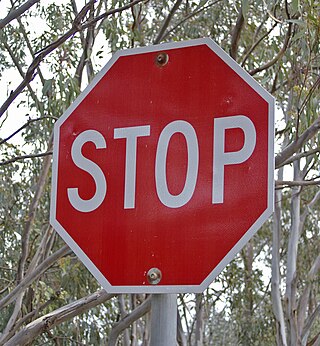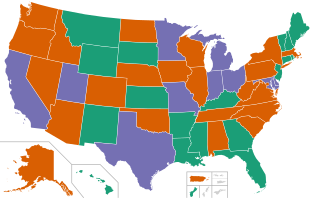Standard rules
| State-specific rules |
List of some standard rules of the road:
- Entering and leaving roadways.
- Right of way at marked and unmarked intersections under various conditions.
- Observing and interpreting traffic signs (especially warning, priority or prohibitory traffic signs)
- Keeping to right side (or left side) except to pass others, where passing is allowed.
- Direction of travel and turning (one way, do not enter, no U-turn, etc.)
- Speed, height, width and weight limits.
- Bicycle and pedestrian priority.
- Yielding to special vehicles (emergency, funeral, school bus).
- Vehicle lighting and signalling.
- Stopping if there has been a collision.
Georgia’s new law which took effect from July 1, 2018, prohibits the drivers from holding any devices (Mobile phones or any electronic devices) in hand while driving. [1]
Traffic is required to keep to the right, known as a right-hand traffic pattern. The exception is the US Virgin Islands, where people drive on the left. [2]
Most states in the United States enforce priority to the right at uncontrolled intersections, where motorists must yield to the right. [3]
The two most important differences between U.S. traffic rules and foreign countries' traffic rules are as follows:
- Very heavy use of fully-signed, mandatory 4-way stop signs at intersections (rather than 2-way stops, yields, or roundabouts as in other countries) with priority to the first vehicle (priority to the right if two arrive at the exact same time)
- Traffic lights are normally positioned after the intersection, on the far side from approaching traffic, rather than before [4]
Speed limits

Speed limits are set by each state or territory, as well as counties or municipalities, on the roads within their jurisdiction. The maximum speed limit on rural two-lane roads ranges from 50 mph (80 km/h) in parts of the northeast to 75 mph (120 km/h) in parts of Texas. On rural Interstate Highways and other freeways, the speed limit ranges from 60 mph (96 km/h) in Hawaii to 85 mph (136 km/h) in parts of Texas. All roads in the United States have a speed limit, but it is not always posted (especially in rural areas).
Lane discipline and overtaking
Overtaking, usually called "passing", is legal on all four or more lane roads and on most two-lane roads with sufficient sight distance. On two-lane roads, one must pass to the left of the overtaken vehicle unless that vehicle is preparing to make a left turn, in which case the vehicle must be passed on the right. Passing on the left means that the overtaking vehicle must enter the oncoming lane. This should only be done in a legal passing zone, designated by either a dashed yellow center-line (indicating that passing is legal in both directions) or a solid line paired with a dashed line (indicating that passing is only legal for traffic adjacent to the broken line). A solid double yellow line indicated that passing is illegal in both directions. In some states, it is not against the law to overtake vehicles in the presence of solid yellow lines if it is safe to do so. For example, Vermont state law also allows passing across the double yellow line when no traffic is on the opposing side; however, one must pass quickly and return to the proper side. [5] However, this is unusual as most states have a ban on crossing a double yellow line except when turning, or when pedestrians, bicycles, or other obstructions in the road make it necessary. Overtaking another vehicle across a solid yellow line is usually considered a serious traffic violation in most states. [5]
On roads with four or more lanes (including divided highways), vehicles may pass to the left or to the right of slower vehicles as long as the maneuver can be completed safely. However, most states either suggest or require that through traffic stay to the right except to pass. [6] The Manual on Uniform Traffic Control Devices includes several signage standards to inform drivers of proper lane discipline, including the "STAY RIGHT PASS LEFT" and "SLOWER TRAFFIC KEEP RIGHT" signs. [7]
Seat belt use
49 states, the District of Columbia and the five inhabited territories have passed laws requiring seat belt use by at least all occupants of the front seat. New Hampshire is the only state with no such requirement for adults (anyone under eighteen must use a seat belt). Some states also require rear seat occupants to wear seat belts. In 24 states, the seat belt law is considered to be only a secondary offense, meaning that a police officer can only ticket a person for violating the seat belt law if the driver has already been stopped for another reason. The effectiveness of seat belt laws varies considerably throughout the country, with some areas observing over 95% usage and others with less than 40% usage.
Road signs
In the United States, road signs are, for the most part, standardized by federal regulations, most notably in the Manual on Uniform Traffic Control Devices (MUTCD) and its companion volume the Standard Highway Signs (SHS). Under a federal regulation promulgated by the Federal Highway Administration pursuant to the Highway Safety Act, states must remain in "substantial conformance" with the MUTCD. [8] This standard does not require states to precisely conform to the MUTCD, which allows for a degree of local variation in certain minor aspects of road signs and markings.















